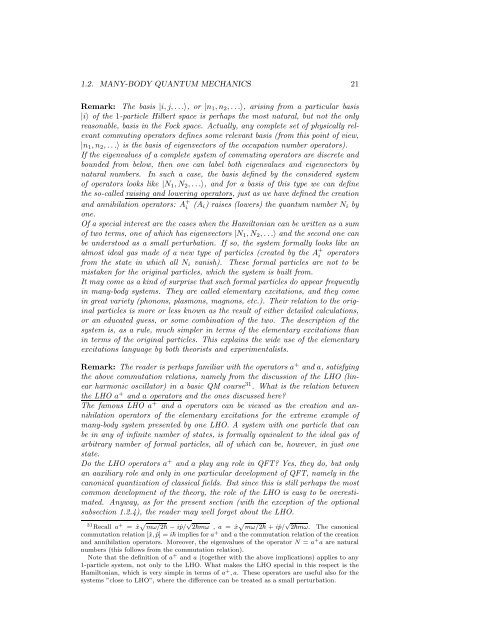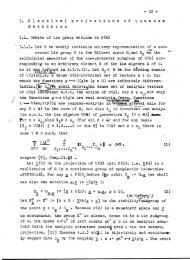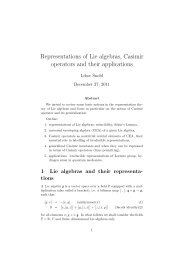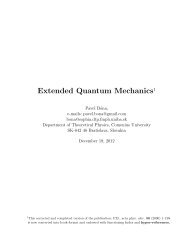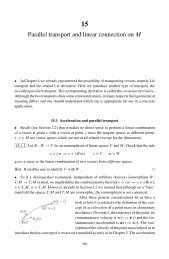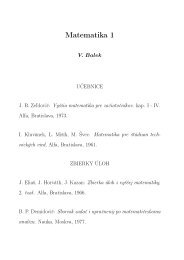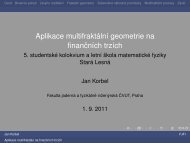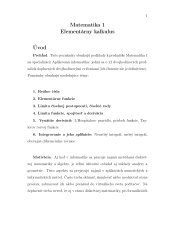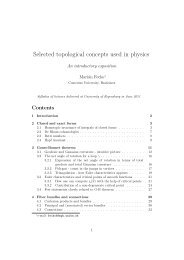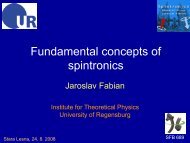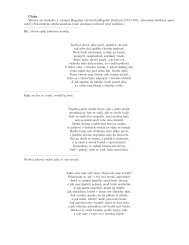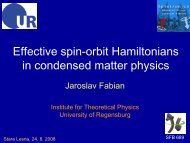Quantum Field Theory I
Quantum Field Theory I
Quantum Field Theory I
You also want an ePaper? Increase the reach of your titles
YUMPU automatically turns print PDFs into web optimized ePapers that Google loves.
1.2. MANY-BODY QUANTUM MECHANICS 21<br />
Remark: The basis |i,j,...〉, or |n 1 ,n 2 ,...〉, arising from a particular basis<br />
|i〉 of the 1-particle Hilbert space is perhaps the most natural, but not the only<br />
reasonable, basis in the Fock space. Actually, any complete set of physically relevant<br />
commuting operators defines some relevant basis (from this point of view,<br />
|n 1 ,n 2 ,...〉 is the basis of eigenvectors of the occupation number operators).<br />
If the eigenvalues of a complete system of commuting operators are discrete and<br />
bounded from below, then one can label both eigenvalues and eigenvectors by<br />
natural numbers. In such a case, the basis defined by the considered system<br />
of operators looks like |N 1 ,N 2 ,...〉, and for a basis of this type we can define<br />
the so-called raising and lowering operators, just as we have defined the creation<br />
and annihilation operators: A + i (A i ) raises (lowers) the quantum number N i by<br />
one.<br />
Of a special interest are the cases when the Hamiltonian can be written as a sum<br />
of two terms, one of which has eigenvectors |N 1 ,N 2 ,...〉 and the second one can<br />
be understood as a small perturbation. If so, the system formally looks like an<br />
almost ideal gas made of a new type of particles (created by the A + i operators<br />
from the state in which all N i vanish). These formal particles are not to be<br />
mistaken for the original particles, which the system is built from.<br />
It may come as a kind of surprise that such formal particles do appear frequently<br />
in many-body systems. They are called elementary excitations, and they come<br />
in great variety (phonons, plasmons, magnons, etc.). Their relation to the original<br />
particles is more or less known as the result of either detailed calculations,<br />
or an educated guess, or some combination of the two. The description of the<br />
system is, as a rule, much simpler in terms of the elementary excitations than<br />
in terms of the original particles. This explains the wide use of the elementary<br />
excitations language by both theorists and experimentalists.<br />
Remark: The reader is perhaps familiar with the operators a + and a, satisfying<br />
the above commutation relations, namely from the discussion of the LHO (linear<br />
harmonic oscillator) in a basic QM course 31 . What is the relation between<br />
the LHO a + and a operators and the ones discussed here<br />
The famous LHO a + and a operators can be viewed as the creation and annihilation<br />
operators of the elementary excitations for the extreme example of<br />
many-body system presented by one LHO. A system with one particle that can<br />
be in any of infinite number of states, is formally equivalent to the ideal gas of<br />
arbitrary number of formal particles, all of which can be, however, in just one<br />
state.<br />
Do the LHO operators a + and a play any role in QFT Yes, they do, but only<br />
an auxiliary role and only in one particular development of QFT, namely in the<br />
canonical quantization of classical fields. But since this is still perhaps the most<br />
common development of the theory, the role of the LHO is easy to be overestimated.<br />
Anyway, as for the present section (with the exception of the optional<br />
subsection 1.2.4), the reader may well forget about the LHO.<br />
31 Recall a + = ˆx √ mω/2 − iˆp/ √ 2mω , a = ˆx √ mω/2 + iˆp/ √ 2mω. The canonical<br />
commutation relation [ˆx, ˆp] = i implies for a + and a the commutation relation of the creation<br />
and annihilation operators. Moreover, the eigenvalues of the operator N = a + a are natural<br />
numbers (this follows from the commutation relation).<br />
Note that the definition of a + and a (together with the above implications) applies to any<br />
1-particle system, not only to the LHO. What makes the LHO special in this respect is the<br />
Hamiltonian, which is very simple in terms of a + ,a. These operators are useful also for the<br />
systems ”close to LHO”, where the difference can be treated as a small perturbation.


